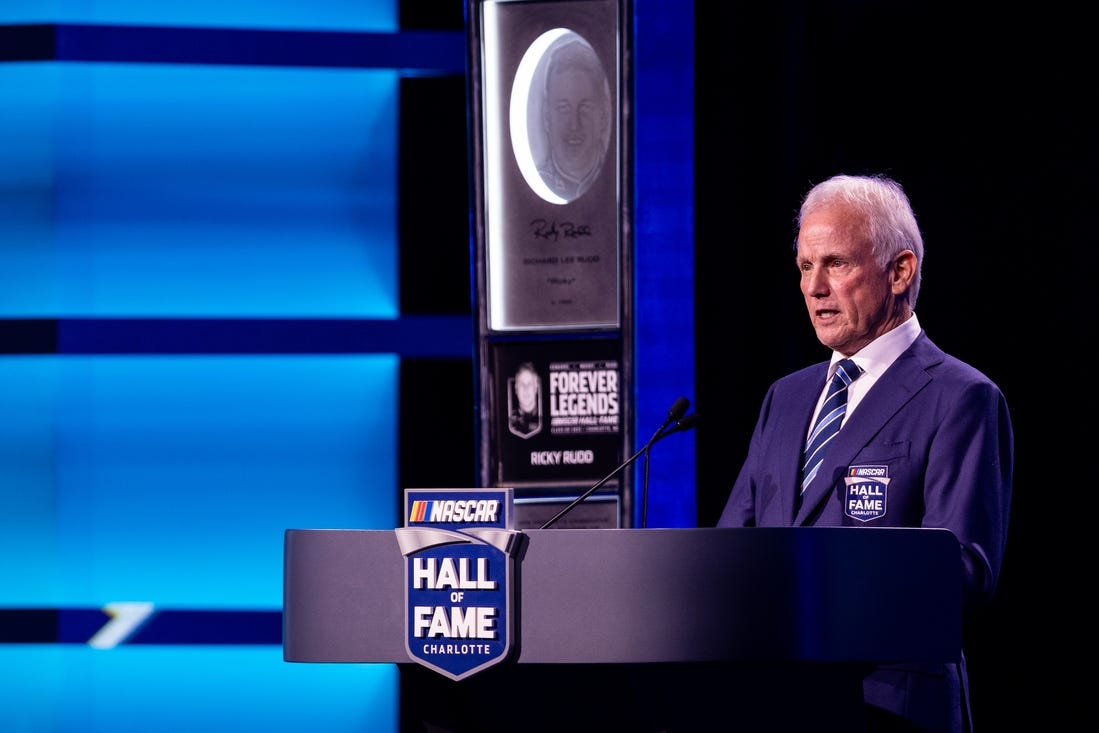
CHARLOTTE, N.C. — NASCAR’s heroes and legends gathered at the NASCAR Hall of Fame on Friday to formally induct the esteemed class of 2025 — racing greats Ricky Rudd, Carl Edwards and the late Ralph Moody.
They — along one of the sport’s great safety innovators, Dr. Dean Sicking, and one of its most accomplished storytellers, Associated Press reporter Mike Harris — were celebrated for their important contributions to stock car racing.
Hundreds of fans began crowding the lobby of the NASCAR Hall of Fame early in the afternoon, hours before their heroes arrived — their cameras pointed toward the red carpet and applause finally greeting each of the honored guests, from one of the Hall’s original inductees, seven-time NASCAR Cup Series champion Richard Petty to beloved driver Donnie Allison to a pair of the most successful crew chiefs in racing history, Ray Evernham and Chad Knaus.
But the cheers rang loudly and cell phone cameras flashed rapidly filling the room when Rudd and Edwards arrived on the red carpet.
In a 13-year NASCAR Cup Series career, Edwards won 28 races, including the Southern 500 at Darlington (S.C.) and the Coca-Cola 600 at Charlotte. He was a two-time NASCAR Cup Series championship runner-up, losing out on the 2011 title in the closest title race in history — a tiebreaker with fellow NASCAR Hall of Famer Tony Stewart.
In all, Edwards earned 72 victories in the three national series, including the 2007 NASCAR Xfinity Series championship. In 2005, he competed full time in both the NASCAR Craftsman Truck Series and Xfinity Series.
Nearly two hundred people — Edwards’ family, friends and most ardent career supporters — accompanied the 45-year old Missourian to North Carolina for the career-defining moment on Friday. One of his former car owners, fellow NASCAR Hall of Famer Joe Gibbs, rented an airplane for Edwards to transport his large group of support from Missouri.
Edwards explained that during his career fans watched him do his signature backflips to celebrate race wins, but that was only a momentary snapshot and that he probably did not allow himself the real time to cherish the victories as he should have.
“So, I said, we’re going to make sure there is a real celebration,” Edwards said. “For many reasons I’m happy to be able to come back and thank everyone. It’s not reality, not for me yet. … I don’t even know what to say. It feels … very good.”
In speaking to the Hall on stage during his official induction, Edwards called his message one of “gratitude” — thanking his parents, wife, children, longtime fans and Hall of Fame team owners Jack Roush and Gibbs, his competitors and all those that worked on his teams.
“Thanks for making me part of your family. Thank you NASCAR,” he said.
It was a similarly moving induction experience for Rudd, known as one of the toughest competitors in the sport’s history. His first NASCAR start of any kind came in the NASCAR Cup Series and he finished 11th in that 1975 debut at Rockingham, N.C. as an 18-year old — earning his first of 374 career top-10s the following week at Bristol, Tenn. In 1983, at the age of 24, he became the youngest pole winner in Daytona 500 history.
Rudd, 68, of Chesapeake, Va., would go on to earn 23 career NASCAR Cup Series victories including the 1997 Brickyard 400 as an owner-driver and the 1992 International Race of Champions (IROC) title in his first year in the series.
He is best-known however for his singular toughness — 16 consecutive years (1983-98) with a victory at the sport’s highest level and his string of 788 straight starts was a record that lasted until 2015. His 905 total starts in a career that spanned four decades is second only to the seven-time NASCAR champion Petty’s 1,185 starts.
“With the help of a lot of great people I was able to chase a lot of dreams, and with tonight’s induction, that dream is now complete,” said Rudd, who thanked his family, fans, wife Linda and son Landon, noting that Linda “has not only been my wife and best friend for 45 years, she mentally drove every lap with me.”
“NASCAR allowed me to experience things most people will never do. I got to fly with the Blue Angels. I shook the hands of two presidents, refueled with the Air Force Thunderbirds high above the Nevada desert and play a small role in a movie. … This is truly the honor of a lifetime.”
Moody, who died in 2004, served under Gen. George Patton in World War II before becoming a full-time driver and winning five times in NASCAR’s premier division in 1956-57. But his legacy was only beginning. In 1957, he partnered with John Holman to form the iconic Holman-Moody Racing company — building cars and creating innovations that produced 96 Cup wins from 1957-72 and winning the 1968-69 Cup Series championships with driver David Pearson.
“If not for Ralph Moody, there probably wouldn’t be a Bobby or Donnie Allison, he’s just a fantastic man,” Donnie Allison said, bringing Moody’s son and daughter to the stage for the official Hall of Fame ring presentation.
“It is with great pride and gratitude I stand here tonight to honor my father,” the younger Ralph Moody told the crowd of his father’s unlikely rise from a Massachusetts farm into NASCAR’s most esteemed hall of honor.
“For dad it was never just about winning, it was about creating safety not just being faster,” Moody said, ending the acceptance speech with an emotion-filled thank you to his father.
Dr. Dean Sicking was given the Landmark Award for his Outstanding Contributions to NASCAR that included his work alongside the University of Nebraska-Lincoln in creating of SAFER (Steel And Foam Energy Reduction) barriers that now line the walls at all race tracks hosting one of NASCAR’s three top-level divisions.
Harris was awarded the Squier-Hall Award for NASCAR Media Excellence for his four decades work as the lead motorsports writer for the AP before retiring in 2009.
–By Holly Cain, NASCAR Wire Service. Special to Field Level Media.


